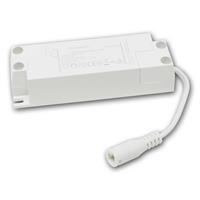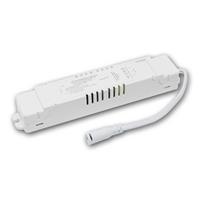Constant current transformer
Constant current sources serve as current converters and power supply for Highpower-LEDs. LEDs or light emitting diodes are non-linear resistors and run with low-level direct current, that flows in one direction only. Thus, they cannot stand high current, alternating power or power fluctuations. For example, the German electricity grid provides 230V AC/alternating current, a car battery 12V. Therefore, a ballast is necessary to compensate the power out of socket or car battery and to limit the output power (in Ampere), that runs the Hi-power-LEDs. If those LEDs were directly connected to 230V-grid electricity, they might flicker, be damaged and blow. The LED-transformer, a so-called constant current source, regulates the power supply of high-performance LEDs.
Comparison of direct current transformer and electronic ballast (EVG)
Halogen lights often already have an electronic ballast (EVG). If these are to be exchanged for energy-saving LED lamps, the question often arises as to whether the existing transformer must be exchanged. Electronic ballasts require a minimum load for operation so that the output voltage levels out exactly. While this is negligible for halogen lamps and does not limit functionality, voltage spikes with LED lamps can cause them to just glow, hum, flash or burn out immediately. In order to be able to enjoy the new LED lighting for a long time, existing electronic ballasts (EVG) should always be replaced with LED direct current transformers.
How is the correct power of the LED transformer determined?
To determine the correct power of the required LED transformer, in addition to the total power of the LED lamps to be used, a reactive power of at least 30% (comes from the mains and flows back there again) must be taken into account.
In order to determine the total output of the LEDs, the individual output of each LED light source must be added up. If, for example, 6 lamps with 3 watts each are to be used, this results in a total output of 18 watts. The reactive power of 30% results in 6 watts and therefore an LED power supply unit with at least 24 watts is required. If a more powerful LED ballast is used, the LEDs can be expanded in the future or replaced with lamps with a higher output.









